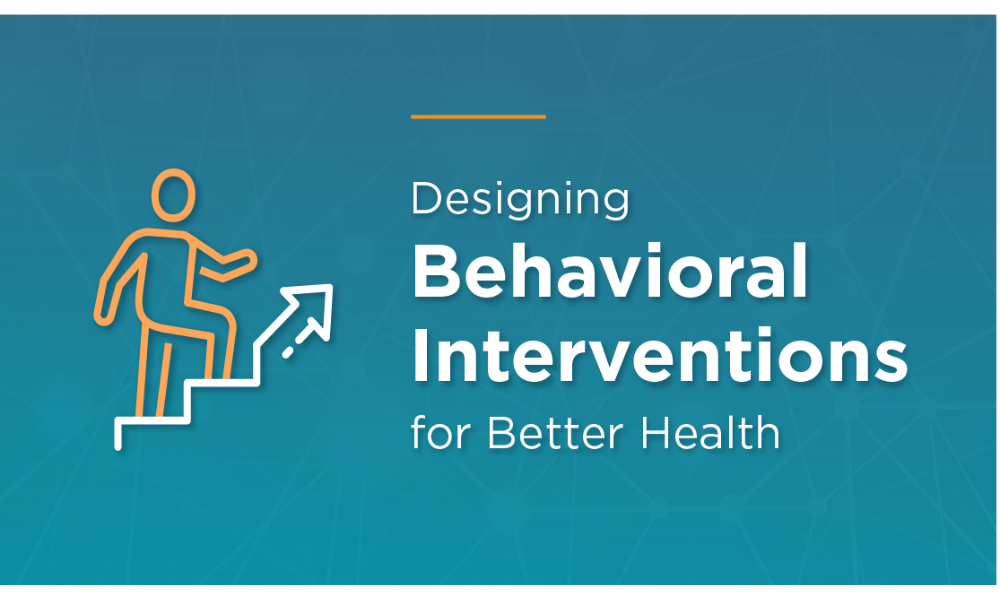Behavioral interventions are techniques to help shape thoughts and actions so people may achieve goals and reach desired outcomes. They can be used in many contexts including digital products for health, where they encourage certain behaviors while discouraging others. Interventions that enable people to make choices that lead to good health outcomes will ultimately increase the value of your products.
Imagine you are developing products for managing a chronic condition such as heart disease. A patient undergoing treatment might use a mobile application that supports maintaining an active lifestyle. Through the app, they receive suggestions for physical activities based on their current heart health metrics and personal activity preferences. The clinician tracking the patient’s progress uses a desktop application to provide timely feedback and touchpoints of care. The patient’s caregiver might receive text messages about progress milestones and health appointment reminders to help them stay engaged with the patient’s treatment plan. Each situation is shaped with a behavioral technique that encourages effective behavior.
There are benefits to defining behavioral intervention rather than leaving user behavior to chance. Having a behavioral intervention makes it clear what type of metrics will determine the success of the product or service. Short-term metrics can be simple traditional click data, choosing one option over another, or the number of completed tasks, such as how often a person engages in moderate exercise. Long-term metrics could include biometric data trends or changes in treatment, such as a reduction in medication.

Knowing and defining intended user behavior at the beginning of a design project gives product development teams user-centered goals and objectives to focus on throughout design and implementation. Not only will a product designer have a clear direction, but the entire team implementing the product will be aligned with the same outcomes.
This might all sound like a labor-intensive process to implement, but it’s possible to start with the basics and build upon a foundation. In fact, mature product design teams can do this already. It begins with a research and discovery phase where an assessment is made to determine what condition needs to be addressed through behavioral intervention, such as participation in exercise, for example. After a period of exploration, solutions, and product requirements are made in light of the findings. Once everyone’s satisfied with the definitions, a solution is implemented in the product and finally, evaluated with meaningful metrics after it’s put into use.
With the help of behavioral intervention, digital health products can be designed to encourage desired behaviors while discouraging undesirable ones. This helps to improve user engagement, increase customer satisfaction, and ultimately drive business growth. Get started with behavioral interventions today and take user-centered product design to a new level.
FAQ’s
1. What are behavioral interventions and how do they apply to digital health products?
Behavioral interventions are essentially strategies used to influence thoughts and actions, guiding users towards achieving specific goals. In the context of digital health products, these interventions encourage healthy behaviors while discouraging unhealthy ones. By promoting choices that lead to positive health outcomes, you enhance the overall value of your product.
2. Can you provide an example of a behavioral intervention in a digital health product?
Imagine a mobile application designed to manage chronic conditions like heart disease. The app might provide personalized physical activity suggestions based on a user’s current health data and preferences. Additionally, a clinician could utilize a desktop application to monitor the user’s progress and offer timely feedback and support. Even caregivers could be integrated into the system, receiving text-message updates on the user’s progress and appointment reminders, fostering their active participation in the user’s health journey. Each touchpoint within this system exemplifies a behavioral intervention designed to steer users towards effective self-management.
3. What are the benefits of defining behavioral interventions?
Clearly outlining the desired behavioral outcomes helps establish the metrics used to gauge the product’s success. Short-term metrics might involve traditional user interaction data like clicks, navigation choices, or task completion rates (e.g., frequency of exercise sessions). Long-term metrics could encompass trends in biometric data or treatment changes (e.g., reduced medication requirements).
4. Why is it important to define user behavior at the outset of a design project?
Defining intended user behavior from the start provides product development teams with a user-centric foundation. This clarity fosters a shared vision throughout the design and implementation phases. With a well-defined target behavior, product designers have a clear direction, and the entire development team stays focused on achieving the same goals.
5. How can I incorporate behavioral interventions into my digital health product?
While it might seem like a complex undertaking, implementing behavioral interventions can be a gradual process. Even mature product design teams can integrate these principles by starting with a research and discovery phase. Here, the team identifies the specific health condition that the product aims to address through behavioral interventions (e.g., promoting exercise adherence). Following this exploration phase, solutions and product requirements are formulated based on the research findings. Once everyone is aligned on the desired behaviors, these interventions are implemented within the product. Finally, after launch, the product’s effectiveness is evaluated using relevant metrics.
By strategically incorporating behavioral interventions, digital health products can be designed to motivate positive behaviors and discourage negative ones. This user-centered approach leads to improved user engagement, increased customer satisfaction, and ultimately, business growth for your digital health product. Sunrise Labs is here to help you leverage the power of behavioral design in your healthcare applications. Contact us today to learn more about how our UX/UI design expertise can elevate your product to the next level.







